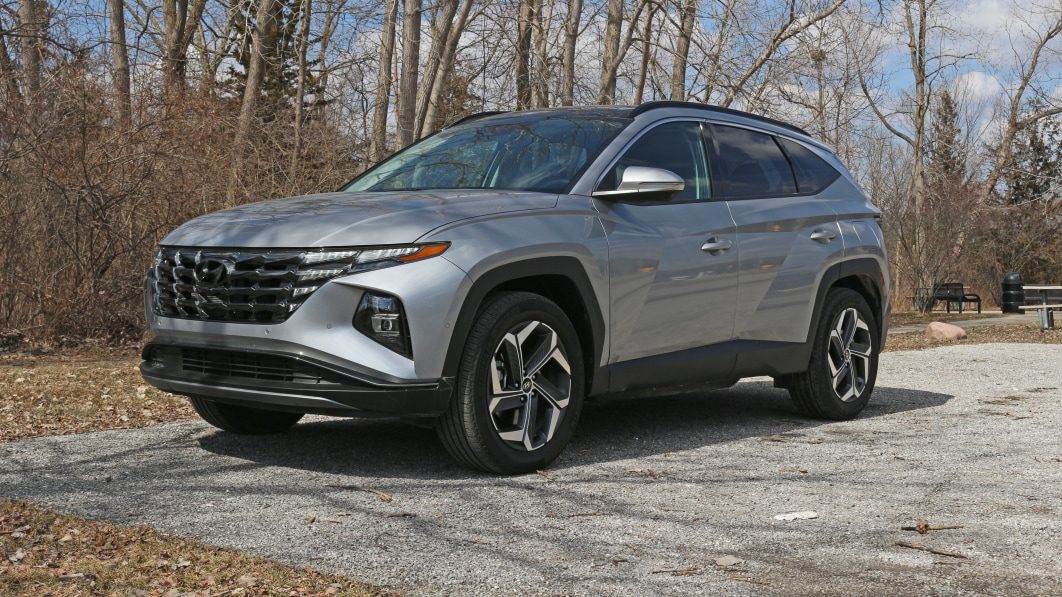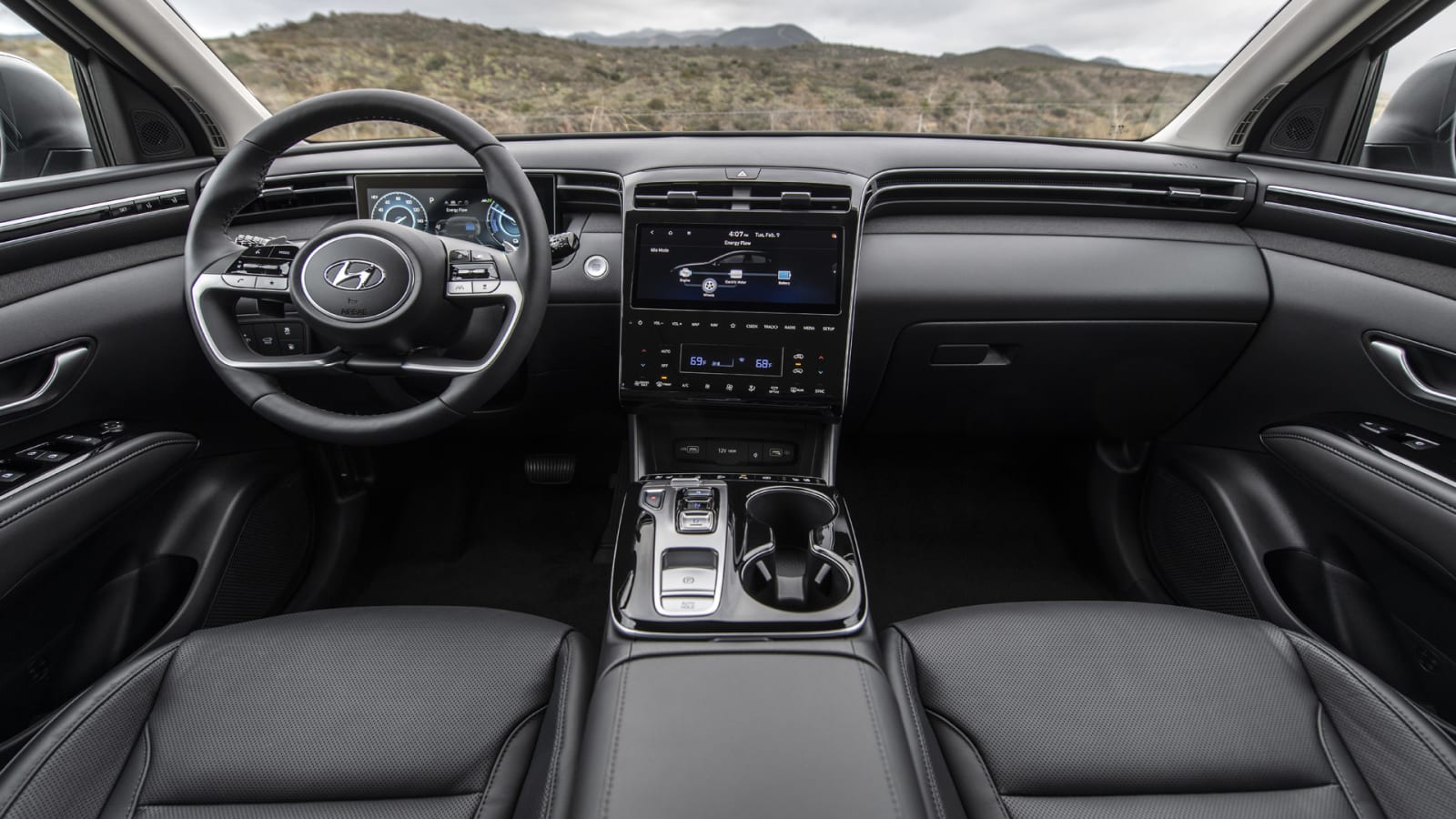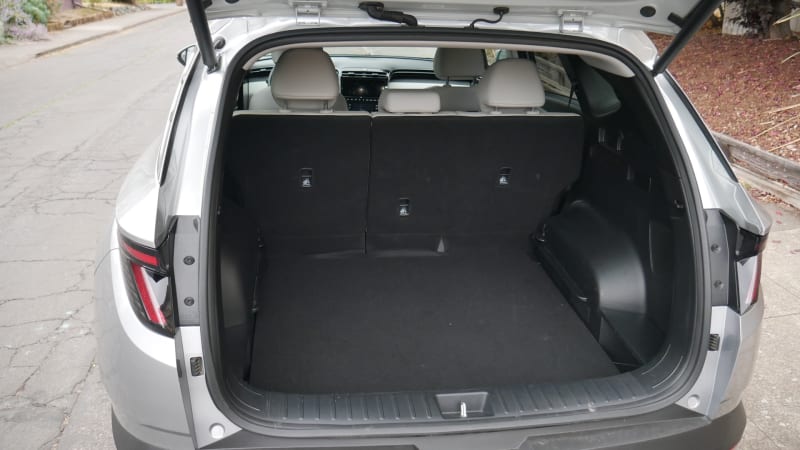2023 Hyundai Tucson Review: Great hybrids, wild style, big space

Pros: All-star hybrid powertrain; excellent tech; huge cargo area; high-quality cabin
Cons: Sad sack base engine; some weird interior controls; a bit blah to drive
You have to give the designers of the 2023 Hyundai Tucson credit: They really went for it. In a segment long known for bland anonymity, the Tucson is an explosion of sharp creases, odd bulges and a smiling grille that lights up on its edges like a Vegas marquee. The wheel arches are angular rather than actual arches, there are diamond shapes embossed in the rear bumper, and LED taillights that dangle from a full-width light bar like Dracula fangs. There’s A LOT going on. Maybe too much, but hey, better than dull.
And, importantly, all of the above adorns a solid entry in the ultra-competitive compact SUV segment. It’s really big, for one, besting the cargo capacity of the Toyota RAV4 and last-gen CR-V, and offering similar passenger-hauling capability. It has a nicer interior than both, too, with much better infotainment and safety technology. The Tucson Hybrid’s powertrain is also an all-star, uniquely combining a turbocharged engine, electric motor and six-speed automatic to create a powertrain that is surprisingly powerful and refined, thrifty as expected, and pleasingly normal to drive. The Tucson Plug-In Hybrid steps all that up even further. Unfortunately, the base engine is a real slug, and worse, is the only way to get the more characterful N Line and XRT trim levels. We’d likely choose another compact SUV over a gas-only Tucson, but the Hybrid? Definitely check that out. And if A LOT is not what you’re going for stylistically, the 2023 Kia Sportage is mechanically related.
Interior & Technology | Passenger & Cargo Space | Performance & Fuel Economy
What it’s like to drive | Pricing & Trim Levels | Crash Ratings & Safety Features
What’s new for 2023?
Forward collision warning and adaptive cruise control with stop-and-go capability are now standard on every trim level, while all but the base trim now comes standard with a hands-free liftgate and wireless device charging. This is also the first full model year for the plug-in hybrid, the sportier Tucson N Line and the more rugged Tucson XRT.
What are the Tucson interior and in-car technology like?
In a segment where many competitors go with a more functional aesthetic, the Hyundai Tucson is more stylish, more tech-focused and more premium. We especially like the dash-width vents and cloth trim. Plastics and switchgear are of a high quality as well. There are some key differences based on trim level, however. Besides upholstery and color choices, the center stack controls actually differ. The SE and SEL come with an 8-inch touchscreen, while an upgrade 10.25-inch widescreen unit is standard on everything else (plus the SEL’s Convenience package). Their basic user interface is similar, but the bigger screen increases functionality. Unusually, only the 8-inch screen is compatible with wireless Android Auto and Apple CarPlay; the larger unit requires a wired connection. This is true of most recent Hyundai products, and the 10.25-inch system will get new hardware in future model years to address this.
With either, Hyundai ditched a traditional volume knob and other physical controls, which is a downgrade. The 8-inch screen is paired scroll wheels for volume and tuning (below left), which is technically better than the tap-tap-tapping you have to do with the all-touch controls paired with the 10.25-inch unit (below right), but they’re still strange. Touch-sensitive controls have also historically been difficult to find and successfully press while driving, and these are no different. All that piano black trim also means lots and lots of fingerprints.
Otherwise, the front seats are comfortable and supportive with excellent adjustment on higher trims (base models get just six-way manual adjustment). Rear-seat recline and remote fold-down features are standard, and heating for the rear bench is available on the range-topping Limited model.
How big is the Tucson?
For something dubbed a “compact SUV,” the answer is “very big.” With a little help from its new, larger platform, the Tucson grew considerably inside for the 2022 model year. It’s now almost exactly the same size as a Toyota RAV4, Honda CR-V and its mechanically related Kia Sportage cousin, making it one of the largest in the segment. Besides offering plenty of room for adults, we could easily fit a rear-facing child seat while maintaining plenty of space up front for driver and passenger.
Behind the raised back seat, Hyundai now claims 38.7 cubic feet of rear cargo room, which puts it right between the Honda CR-V and Toyota RAV4. At least on paper. As we discovered in our Tucson luggage test, the new Tucson can actually hold a bit more than them when it comes to actual stuff. There is an asterisk, though. Although the Tucson Hybrid has the same cargo capacity on paper as the gas-only version, it does not have a spare tire (like the CR-V Hybrid, but unlike the RAV4 Hybrid). So, you do lose something by adding batteries — it’s just not obvious on the spec sheet or when loading bags.
What are the Tucson fuel economy and performance specs?
The Tucson comes standard with a 2.5-liter inline-four that produces an adequate but uninspiring 187 horsepower and 178 pound-feet of torque. Acceleration tests from various publications have shown a 0-60 “sprint” takes more than 9 seconds, making it one of the slowest vehicles in the segment. EPA fuel economy estimates for 2023 were not available at the time of this writing for any Tucson, but it’s unlikely they would change substantially from their final 2022 estimates. Those were 26 mpg city, 33 mpg highway and 29 mpg combined with standard front-wheel drive and 24/29/26 mpg with optional all-wheel drive.
The 2023 Hyundai Tucson Hybrid is a substantially better choice than the base engine as it represents both a fuel economy and performance upgrade. Its combination of 1.6-liter turbocharged inline-four, electric motor and six-speed automatic transmission produces a total output of 226 hp and 258 lb-ft of torque. That’s a huge jump and one you’ll notice behind the wheel. All-wheel drive is standard, and unlike the Toyota RAV4, it is an actual mechanical AWD system rather than a “through-the-road” system that uses an additional electric motor to power the rear wheels. Last year’s fuel economy estimates were 37 mpg city, 36 mpg highway and 37 mpg combined or 38/38/38 for the base Tucson Hybrid Blue trim level.
The Tucson Plug-In Hybrid basically adds a substantially larger battery pack and a more powerful electric motor to the Tucson Hybrid powertrain. This results in an increase to 261 hp and the same 258 lb-ft of torque, but also allows for 33 miles of all-electric range and a rating of 80 MPG-e from the EPA. That isn’t quite as thrifty as the Toyota RAV4 Prime and Ford Escape PHEV, but if your commute and daily errands fall within that 33 miles (a strong possibility), you’re still going to be rarely filling up.
What’s the Tucson like to drive?
We described the base engine as “adequate but uninspiring” above, which is probably a bit generous. Its sluggish throttle response and reliance on downshifting to maintain speed makes it frustrating to drive in traffic as the eight-speed automatic hunts for gears. More succinctly, it’s just slow, even for a segment where swift acceleration isn’t expected. Unfortunately, the Tucson’s two most distinctive trim levels, the sporty N Line (above left) and off-roadish XRT (above right), come only with the base engine.
We therefore highly recommend the Tucson Hybrid. Not only does it have a better powertrain than the base engine, it’s one of the best options in the entire segment. Its conventional transmission and turbocharged engine provide a quieter and more normal driving experience than that of other hybrid SUVs, while the turbo-plus-electric-motor combo makes it feel notably gutsier around town and when merging onto the highway. The Tucson PHEV, meanwhile, effectively adds even more smooth, effortless electric power to the Hybrid driving experience along with all-electric range.
As for the driving experience beyond the engines, well … it’s not particularly memorable. Body motions are well-controlled, the steering is precise enough, and although the ride may be too firm for some, it doesn’t venture into the land of uncomfortable. Frankly, this is rather par for the course with Hyundais. Basically, you’re not going to buy the Tucson for the way it drives (OK, beyond the sweet turbocharged hybrid powertrain), but it also won’t put you off unless you really want something with verve. If so, one of the Toyota RAV4’s SE trim levels, including the Prime, as well as the Mazda CX-50 would be good calls.
What other Hyundai Tucson reviews can I read?
2022 Hyundai Tucson PHEV First Drive Review
Complete driving impressions and details about the plug-in hybrid Tucson.
2022 Hyundai Tucson First Drive Review
We spent some time with both the 2.5-liter and hybrid models.
2022 Hyundai Tucson driveway and infotainment test
The lack of a volume knob is disappointing, but the loaded-up Tucson’s infotainment is still quite good.
@autoblog
The interior of the 2021 Hyundai Tucson is a very nice place to be ##hyundai ##cars ##carsoftiktok
♬ original sound – Autoblog
2022 Hyundai Tucson Luggage Test
We find out that the Tucson can haul more luggage than any other compact SUV we’ve tested. It may or may not come with a spare tire, though.
What is the 2023 Hyundai Tucson price?
Unfortunately, pricing was not available for the 2023 Tucson at the time of this writing. You will, however, be able to find it here whenever it becomes available for the gas-only Tucson, the Tucson Hybrid and the Tucson Plug-In Hybrid.
As for trim levels, the base SE is only available with the gas engine. The Hybrid’s Blue trim is comparable to the SEL, while the Plug-In Hybrid is offered only as the SEL and Limited. For the most part, these trim levels represent the usual ladder format of more comfort and convenience equipment being added with each rung.
The N Line and XRT are different, however. Both are exclusive to the base engine (boooo), but come with some interesting style upgrades. The N Line has a sporty look, with intricate 19-inch wheels, blacked out grille and badge, different lower fascia, body-colored fender flares, a special shift knob and leather sport seats with cloth inserts. There are no mechanical upgrades. The Tucson XRT is a quasi-rugged offering. It gets burlier matte-finish fender flares, slightly different front and rear fascias, its own 19-inch wheels, crossbars mounted to the Tucson’s standard flush side rails, and a trailer hitch (probably for something like a bike rack or Yakima’s Exo system rather than actually towing). Curiously, it also includes running boards. Considering the XRT has no ground clearance increase, those actually hurt its capability off-road.
What are the Tucson safety ratings and driver assistance features?
Every 2023 Tucson includes forward collision warning and automatic emergency braking (with pedestrian and cyclist detection), blind-spot and rear cross-traffic warning, lane-keeping assist, a driver inattention warning system, safe-exit warning to prevent opening doors into cars or cyclists, and adaptive cruise control with stop-and-go capability. The Limited adds reverse automatic braking, front and rear parking sensors, the blind-spot camera system that displays in the instrument panel, a surround-view parking camera system and Hyundai’s Highway Driving Assist, which adds lane-centering steering assist to the adaptive cruise control system. The ACC also gets an upgrade in the XRT, N Line and Limited that uses the navigation system to increase the steering assistance capability on winding roads.
The Tucson received five out of five stars for crash protection from the National Highway Traffic Safety Administration. The Insurance Institute for Highway Safety gave it the highest accolade of Top Safety Pick+ for its best-possible performance in crashworthiness and crash prevention (aka the performance of all those active safety doo-dads up there). Its standard headlights were rated “Acceptable,” while the Limited’s got a “Good.”













